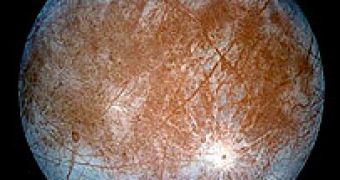We've looked and searched our extraterrestrial cousins throughout the whole solar system, and found no evidence that life may exist in our solar system, beyond the borders of our atmosphere. Only one body seems to present a final hope. One of Jupiter's many moons, Europa. The European Space Agency and NASA both have scheduled missions which involve sending probes to the surface of the icy moon, in order to look for evidence of life. All of a sudden, Russia wants in as well.
Previous orbiting probes sent to study the outer regions of the solar system, revealed that Europa presents a solid surface made out of watery ice. Furthermore, movements of the solid ice sheet covering the whole surface of the moon, suggests that it may have a layer of liquid water right under it, similar to the Earth's north pole which presents a thick layer of ice floating on an ocean of liquid water.
According to Lev Zelyony, head of the Space Research Institute, the mission regarding Europa will be soon inserted in the program of the ESA, and is thought to span somewhere between 2015 to 2025. ESA's program dubbed Laplace, will have the task of landing a robotic probe in the close vicinity of one of the fissures that are routinely created on the moon's surface, by the powerful gravitational interactions with Jupiter.
As soon as it will land, the probe will melt through the thick layer of ice, which could be as deep as a few kilometers, and enter in the predicted ocean of liquid water and look for evidence of the existence of life. Jupiter's Europa is currently the most probable place in the solar system where life could exist, due to the fact that it may hold an ocean of water, and water is one of the most essential substance in the apparition and evolution of life.
After the fall of the Soviet Union in 1991, the Russian space program stopped its exploration activity; it is a well known fact that, during the final years of the MIR space station, the former was mostly supported with the help of NASA, until it was decided that the program should terminate due to multiple failures and to the station's age which made it obsolete in relation to the available technology back on Earth.
Kremlin decided that it's time to bring back to life its former space program and have been discussing with ESA in order to ensure a collaboration. Originally designed for a manned mission to the moon, without using a massive rocket booster such as those of the Saturn V rocket used by NASA, the Soyuz rocket suffered massive modifications and will be tested this year for the first time in one of ESA's launching facilities located in the French Guiana.
Strangely, last year, the Russians also made a contract with NASA, in which they agreed to provide with instrumentation for future moon probing mission. I mean, seriously, where is all the famous American technology?

 14 DAY TRIAL //
14 DAY TRIAL //